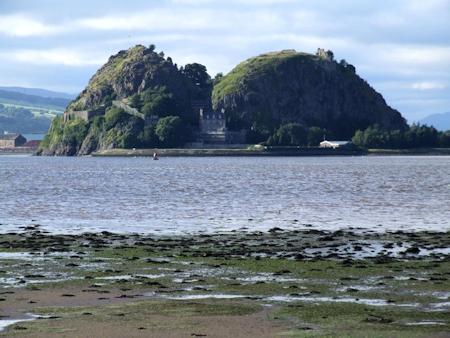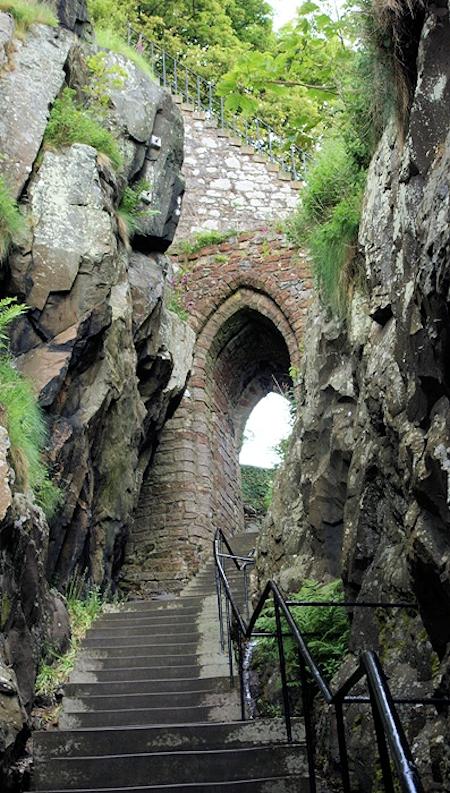
Dumbarton Castle
Standing high on a volcanic outcrop guarding the River Clyde, the site of Dumbarton Castle has been in use for over 1,500 years. In Gaelic it was known as Dun Breatann, 'Fortress of the Britons' and it gave that name to the town of Dumbarton.
From at least the 5th Century to the early 11th Century it was the centre of the British kingdom of Strathclyde and controlled west-central Scotland.
Today nothing really remains of the Dark-Age settlement on the rock. It was sacked by Olaf 'the White' of Dublin in 870 and they carried off everything of value and a huge number of prisoners after a four month siege.
The history around this time is quite unclear. Alexander II's charter for the burgh of Dumbarton mentions the new castle there in 1222. At this point the Norwegians controlled much of Argyll and Dumbarton was right on the border so it's very unlikely to have been abandoned.
The medieval castle was expanded and fortified between the 13th and 17th Centuries. Its great position on the Firth of Clyde with easy access to the open sea and to the west of Scotland ensured it figured prominently in any trouble both domestic and foreign.
Famous Visitors to a Royal Castle
Dumbarton Castle was a royal castle from the start. Robert the Bruce died within sight of it on his nearby estate at the Manor of Cardross. It sheltered David II and his wife for several months after the Scottish defeat at Halidon Hill in 1333. At this point it was one of only five castles holding out for Scotland against the English.
Local legend also has it that Sir William Wallace was kept at the castle as a prisoner in 1305. The Wallace Tower was named in his honour and the Guard House used to be pointed out as "Wallace's Prison". The Wallace Sword, now housed in the Wallace Monument, was also kept here until the late 19th Century.
James IV of Scotland laid siege to the castle twice in 1489 to subdue the Earl of Lennox. His first siege failed, but the second siege succeeded when the great cannon Mons Meg was brought over from Edinburgh Castle. James then used Dumbarton as a base for his attacks against the MacDonald clan, Lords of the Isles.
Mary, Queen of Scots stayed here as a young child on her way to France in 1548. She stayed there again, briefly, in 1563. The castle was held by her supporters until 1571.
Precious little of the medieval fortress remains at Dumbarton Castle. Like the Dark-Age fortress before it, it was removed to make way for more modern fortifications in the 17th Century. The remains of the Wallace Tower and the Portcullis Arch behind the Governor's House are about all that are left.
Gun Batteries and Sea Defences
From the 16th to 18th Century Dumbarton Castle's defences were gradually updated. Gun batteries were installed on the north and eastern walls during the late 16th Century. In 1675 plans were drawn up to repair and improve the castle and these seem to have been carried out.
After the Jacobite Uprising of 1715 the British government decided to remodel the castle defences. There was a major programme of building works during the 1730s, most of which survive today.
The Governor's House was built in 1735 as an impressive residence for the castle's keeper John Kennedy, 8th Earl of Cassilis. It was constructed over the earlier medieval gatehouse. The King George's Battery was also constructed at this time.
Just after the second Jacobite Uprising of 1745 the powder magazine was built on top of the hill. It was designed by William Skinner to secure 150 barrels of gunpowder.
During the Napoleonic Wars the Duke of York's Battery was constructed and the various other batteries were upgraded with much heavier guns. Several other buildings were added including the French Prison.
Tourist Attraction
In the 18th Century Dumbarton Castle's role as a prison and fortress was coming to an end. It was however becoming a tourist attraction. Dr Samuel Johnson visited in 1773 and in 1847 Queen Victoria visited aboard the royal yacht Fairy.
In 1909 the British War Office handed the castle to the Office of Works (which later became Historic Scotland). However, the castle was pressed into service again during the Second World War. An anti-aircraft battery was set up on the rock and in May 1941 four high-explosive bombs landed on it.
The castle is still in the care of Historic Scotland, who have opened it to the public. You can tour the entire site including the guardhouse and the various gun batteries and climb up the many steps to the top of the rock. Facilities available at the site include a gift shop and museum, toilets, tea and coffee facilities and a picnic area.
Status: Visitor Attraction
Owner: Historic Scotland
Tel: +44 (0)1389 732 167
Website: www.historic-scotland.gov.uk
Opening Times: April to September daily 9.30am to 5.30pm / October daily 9.30am to 4.30pm / November to March Mon-Wed and weekends only 9.30am to 4.30pm


Looking across the Clyde to the castle

The medieval Portcullis Arch at Dumbarton Castle